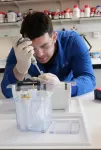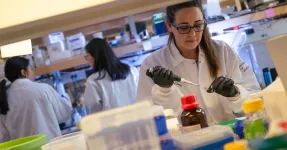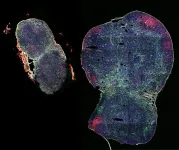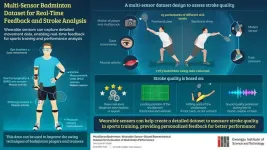(Press-News.org) PULLMAN, Wash. -- Cybersecurity programs vary dramatically across the country, a review has found. The authors argue that program leaders should work with professional societies to make sure graduates are well trained to meet industry needs in a fast-changing field.
In the review, published in the Proceedings of the Association for Computing Machinery’s Technical Symposium on Computer Science Education, a Washington State University-led research team found a shortage of research in evaluating the instructional approaches being used to teach cybersecurity. The authors also contend that programs could benefit from increasing their use of educational and instructional tools and theories.
“There is a huge variation from school to school on how much cybersecurity content is required for students to take,” said co-author Assefaw Gebremedhin, associate professor in the WSU School of Electrical Engineering and Computer Science and leader of the U.S. Department of Defense-funded VICEROY Northwest Institute for Cybersecurity Education and Research (CySER). “We found that programs could benefit from using ideas from other fields, such as educational psychology, in which there would be a little more rigorous evaluation.”
Cybersecurity is an increasingly important field of study because compromised data or network infrastructure can directly impact people’s privacy, livelihoods and safety. The researchers also noted that adversaries change their tactics frequently, and cybersecurity professionals must be able to respond effectively.
As part of the study, the researchers analyzed programs at 100 institutions throughout the U.S. that are designated as a National Security Administration’s National Center of Academic Excellence in Cybersecurity. To have the designation, the programs have to meet the NSA requirements for educational content and quality.
The researchers assessed factors such as the number and type of programs offered, the number of credits focused on cybersecurity courses, listed learning outcomes and lists of professional jobs available for graduates.
They found that while the NSA designation provides requirements for the amount of cybersecurity content included in curricula, the center of excellence institutions vary widely in the types of programs they offer and how many cybersecurity-specific courses they provide. Half of the programs offered bachelor’s degrees, while other programs offered certificates, associate degrees, minors or concentration tracks.
The most common type of program offered was a certificate, and most of the programs were housed within engineering, computer science, or technology schools or departments. The researchers found that industry professionals had different expectations of skill levels from what graduates of the program have.
The researchers hope the work will serve as a benchmark to compare programs across the U.S. and as a roadmap toward better meeting industry needs.
With funding from the state of Washington, WSU began offering a cybersecurity degree last year. The oldest cybersecurity programs are only about 25 years old, said Gebremedhin, but programs have traditionally been training students to become information technology professionals or system administrators.
“In terms of maturity, in being a discipline as a separate degree program, cybersecurity is relatively new, even for computer science,” said Gebremedhin.
The field is also constantly changing.
“In cyber operations, you want to be on offense,” he said. “If you are to defend, then you need to stay ahead of your attacker, and if they keep changing, you have to be changing at a faster rate.”
This work was supported by the U.S. Department of Defense in collaboration with the Air Force Research Laboratory and Griffiss Institute.
END
Cybersecurity education varies widely in US
2024-05-06
ELSE PRESS RELEASES FROM THIS DATE:
New vaccine effective against coronaviruses that haven’t even emerged yet
2024-05-06
Researchers have developed a new vaccine technology that has been shown in mice to provide protection against a broad range of coronaviruses with potential for future disease outbreaks - including ones we don’t even know about.
This is a new approach to vaccine development called ‘proactive vaccinology’, where scientists build a vaccine before the disease-causing pathogen even emerges.
The new vaccine works by training the body’s immune system to recognise specific regions of eight different coronaviruses, including SARS-CoV-1, SARS-CoV-2, and several that are ...
Simulated chemistry: New AI platform designs tomorrow’s cancer drugs
2024-05-06
Scientists at UC San Diego have developed a machine learning algorithm to simulate the time-consuming chemistry involved in the earliest phases of drug discovery, which could significantly streamline the process and open doors for never-before-seen treatments. Identifying candidate drugs for further optimization typically involves thousands of individual experiments, but the new artificial intelligence (AI) platform could potentially give the same results in a fraction of the time. The researchers used the new tool, described in Nature Communications, to synthesize 32 new drug candidates for cancer.
The technology is part of a new but growing trend ...
Human ‘neural compass’ pinpointed in new study
2024-05-06
A pattern of brain activity that helps prevent us from getting lost has been identified in a new study, published in Nature Human Behaviour.
Researchers at the University of Birmingham and Ludwig Maximilian University of Munich have for the first time been able to pinpoint the location of an internal neural compass which the human brain uses to orientate itself in space and navigate through the environment.
The research identifies finely tuned head direction signals within the brain. The results are comparable to neural codes identified in ...
Personalized screening early in pregnancy may improve preeclampsia detection
2024-05-06
Research Highlights:
A personalized screening algorithm for preeclampsia in the first trimester of pregnancy may help clinicians better predict who is at risk for developing the condition and who may benefit from treatment with a daily, low-dose aspirin.
In this study of more than 7,000 women, the new screening method, which combined maternal history, biomarker tests and ultrasound tests, was better at identifying preeclampsia risk in than current risk factor-based guidelines.
Embargoed until 4 a.m. CT/5 a.m. ET Monday, May 6, 2024
DALLAS, May 6, 2024 — A new screening algorithm for preeclampsia combining maternal history, ...
Expanding a lymph node, boosting a vaccine
2024-05-06
Expanding a lymph node, boosting a vaccine
A biomaterial vaccine enhances and sustains lymph node expansion following vaccination, boosting anti-tumor immunity in an animal model.
By Benjamin Boettner
(BOSTON) — Each one of us has around 600 lymph nodes (LNs) – small, bean-shaped organs that house various types of blood cells and filter lymph fluid – scattered throughout our bodies. Many of us have also experienced some of our LNs to temporarily swelling during infections with viruses or other pathogens. This LN expansion and subsequent contraction can also result from vaccines injected nearby, and in fact ...
GIST-MIT CSAIL researchers develop a biomechanical dataset for badminton performance analysis
2024-05-06
In sports training, practice is the key, but being able to emulate the techniques of professional athletes can take a player’s performance to the next level. AI-based personalized sports coaching assistants can make this a reality by utilizing published datasets. With cameras and sensors strategically placed on the athlete's body, these systems can track everything, including joint movement patterns, muscle activation levels, and gaze movements.
Using this data, personalized feedback is provided on player technique, along with improvement recommendations. Athletes can access this feedback anytime, and anywhere, making these systems versatile for athletes at ...
Study sheds light on 11th century Arab-Muslim optical scientist whose work laid ground for modern-day physics
2024-05-06
Scientists from the University of Sharjah and the Warburg Institute are poring over the writings of an 11th century Arab-Muslim polymath to demonstrate their impact on the development of optical sciences and how they have fundamentally transformed the history of physics from the Middle Ages up to modern times in Europe.
Their research focuses on the legacy of al-Ḥasan Ibn al-Haytham known in Latin as “Alhazen” and particularly his most influential work titled Book of Optics, reputed in Arabic as Kitab al-Manazir and first circulated in Europe via its Latin translation dubbed ‘Perspectiva’. Ibn ...
Rethinking “socially admitted” patients
2024-05-06
Labelling vulnerable patients in hospital as “socially admitted” may prevent treatment of medical issues, according to new research in CMAJ (Canadian Medical Association Journal) https://www.cmaj.ca/lookup/doi/10.1503/cmaj.231430.
Emergency departments are the last resort for some socially vulnerable people who may not have an acute or new medical issue. They may be seeking care because of a breakdown of supports or the inability of the patient, or their family, to cope with living at home. These people are known colloquially as “social admissions,” and other labels such as “orphan patient,” “failure ...
A better way to ride a motorcycle
2024-05-06
Motorcycles are designed to accommodate the average-sized rider, leaving taller and shorter riders vulnerable to discomfort.
A new study from the University of Waterloo used software that predicted realistic motorcycle riding behaviours, considering human factors and ergonomic trade-offs. It found that shorter and taller statures require joint adjustments to achieve their preferred riding posture.
Taller riders are required to flex their ankles, knees, hips and elbows more to interact with the motorcycle properly, ...
Survey of US parents highlights need for more awareness about newborn screening, cystic fibrosis and what to do if results are abnormal
2024-05-05
A national survey led by Ann & Robert H. Lurie Children’s Hospital of Chicago found that parents have insufficient knowledge of newborn screening in general and of cystic fibrosis (CF) in particular. Researchers asked specific questions about CF based on studies showing that initial CF follow-up visits after a positive newborn screening often occur after 4 weeks of age, which is later than the recommended timeframe for best outcomes. Later follow-up is associated with worse nutrition in childhood, a predictor of long-term health in CF. Parents ...





